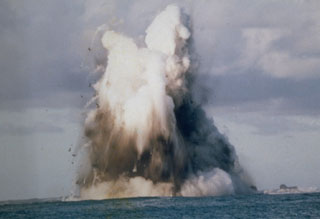Report on Nishinoshima (Japan) — 15 January-21 January 2020
Smithsonian Institution / US Geological Survey
Weekly Volcanic Activity Report, 15 January-21 January 2020
Managing Editor: Sally Sennert.
Please cite this report as:
Global Volcanism Program, 2020. Report on Nishinoshima (Japan) (Sennert, S, ed.). Weekly Volcanic Activity Report, 15 January-21 January 2020. Smithsonian Institution and US Geological Survey.
Nishinoshima
Japan
27.247°N, 140.874°E; summit elev. 100 m
All times are local (unless otherwise noted)
The Japan Coast Guard (JCG) reported that during an overflight of Nishinoshima conducted from 1335 to 1412 on 17 January surveyors observed continuous gray emissions rising from the central crater of the pyroclastic cone to 1.8 km (5,900 ft) a.s.l. and drifting E and NE. The central crater was open to the ENE; lava flows traveled NE and entered the ocean, producing steam plumes at the coastline.
Geological Summary. The small island of Nishinoshima was enlarged when several new islands coalesced during an eruption in 1973-74. Multiple eruptions that began in 2013 completely covered the previous exposed surface and continued to enlarge the island. The island is the summit of a massive submarine volcano that has prominent peaks to the S, W, and NE. The summit of the southern cone rises to within 214 m of the ocean surface 9 km SSE.
Source: Japan Coast Guard

